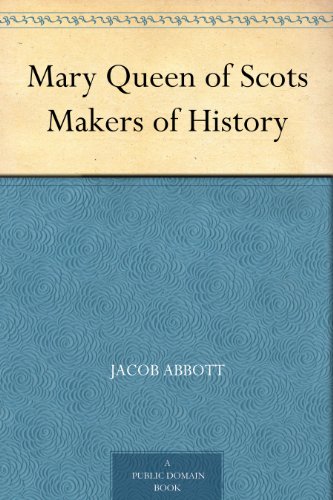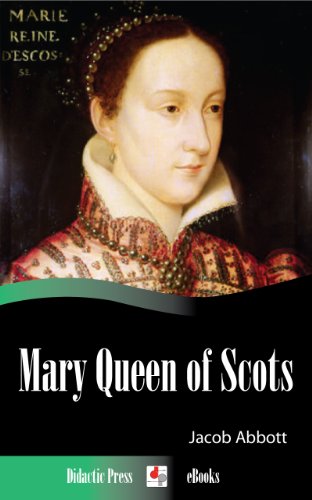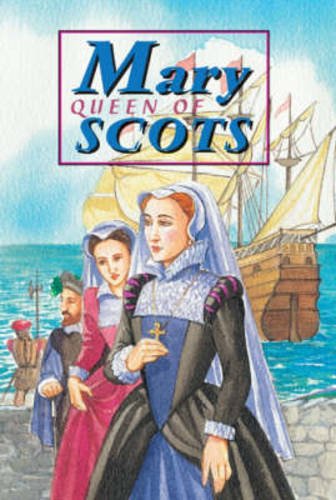-
Mary Queen of Scots Makers of History
Jacob Abbott
language (, March 30, 2011)This book was converted from its physical edition to the digital format by a community of volunteers. You may find it for free on the web. Purchase of the Kindle edition includes wireless delivery.
-
Mary, Queen of Scots
Tim Vicary, Claire Wille, Oxford University Press
Audible Audiobook (Oxford University Press, Dec. 8, 2010)England and Scotland in the 1500s. Two famous queens: Mary, the Catholic Queen of Scots, and Elizabeth I, the Protestant Queen of England. It was an exciting and a dangerous time to be alive - and to be a queen. Mary was Queen of Scotland when she was one week old. At 16, she was also Queen of France. She was tall and beautiful, with red-gold hair. Many men loved her and died for her. But she also had many enemies - men who said: "The death of Mary is the life of Elizabeth." An Oxford Bookworms Library reader for learners of English.
-
Mary Queen of Scots
Jacob Abbott
Hardcover (Harper & Brothers, Jan. 1, 1904)286pp, 12mo
-
Mary, Queen of Scots
Emily Hahn, Walter Buehr
Hardcover (Random House, Jan. 1, 1953)Part of the Landmark series published by Random House
-
Mary Queen of Scots
Jacob Abbott
eBook (Didactic Press, Dec. 30, 2013)A biographical history of the girl who became Queen: Mary, Queen of Scots. A truly tragic story of a girl who would become the embodiment of her own predestined tragedy, this eBook is a must-read for those looking to know more about one of the more fascinating British monarchs.Contents include: Mary's Childhood.Her Education in France.The Great WeddingMisfortunes.Return To Scotland.Mary and Lord Darnley.Rizzio.Bothwell.The Fall of Bothwell.Loch Leven Castle.The Long Captivity.The End.
-
Mary, Queen of Scots
Fiona Macdonald, Damian Zain
Paperback (Sterling Publishing, March 3, 2020)What were some of the world's most famous people like when they were kids? This fresh and fun biography gives kids a peek into the childhood of Mary, Queen of Scots—including the gruesome and ghastly bits! Stunning comic strips, fact boxes, and timelines bring her story to life. By the time she was a year old, Mary, Queen of Scots had faced everything from deadly illness to the threat of kidnapping. She was even engaged to a six-year-old prince! This thrilling biography of the future queen explores all the important events from her childhood, including her dangerous escape from Scotland, marriage into the French royal family, and a young adulthood beset with disasters and deaths. O
O
-
Mary Queen of Scots
Sally Stepanek
Library Binding (Chelsea House Pub, Feb. 1, 1987)Presents the eventful life of the Scottish queen, proclaimed so at the age of one week, who married three times and was beheaded for plotting against her cousin Queen Elizabeth I of England.
-
Mary Queen of Scots
Jacob Abbott
Paperback (CreateSpace Independent Publishing Platform, June 5, 2018)Jacob Abbott (November 14, 1803 – October 31, 1879) was an American writer of children's books. On November 14, 1803, Abbott was born in Hallowell, Maine. Abbott's father was Jacob Abbott and his mother was Betsey Abbott. Abbott attended the Hallowell Academy. Abbott graduated from Bowdoin College in 1820. Abbott studied at Andover Theological Seminary in 1821, 1822, and 1824. Abbott was tutor in 1824–1825. From 1825 to 1829 was professor of mathematics and natural philosophy at Amherst College; was licensed to preach by the Hampshire Association in 1826; founded the Mount Vernon School for Young Ladies in Boston in 1829, and was principal of it in 1829–1833; was pastor of Eliot Congregational Church (which he founded), at Roxbury, Massachusetts in 1834–1835; and was, with his brothers, a founder, and in 1843–1851 a principal of Abbott's Institute, and in 1845–1848 of the Mount Vernon School for Boys, in New York City.
-
Mary, Queen of Scots
Eric Melvin, Aileen Paterson
eBook (, Nov. 17, 2014)|This story is written for 10 - 14 year olds but will also be on interest to those keen to learn more about Mary.On the night of February 7th 1587, Mary, Queen of Scots prepared for her execution at Fotheringhay Castle. What were the thoughts of the captive Queen as her last hours slipped by?Mary was born in Linlithgow Palace on December 8th 1542. As told in the story, Mary was only six days old when her father James V died.Mary was crowned as Queen of Scots at Stirling Castle in September 1543. Her uncle, Henry VIII of England wanted the infant Mary to marry his son Edward. The Scots though refused this proposed marriage. An English army invaded Scotland. Edinburgh was captured in 1544 and burnt to the ground. In August 1548, Mary was sent to France for her safety. There she was brought up in the French Court of Henri II. Mary married Francois, the Dauphin of France on Sunday 24th April 1558 in Notre Dame Cathedral in Paris. Mary was 15, Francois was only 14.In July 1559 her father-in-law, Henri II died. Mary found herself Queen of France as well as Queen of Scots. However her sickly husband died in December the following year.News of her mother’s death in 1560 prompted her decision to return to Scotland where she arrived on 19th August 1561. She was just 19 years of age.For the first 4 years of her reign, Mary ruled the turbulent Scotland well. However Scotland needed an heir. Who should she marry? Mary made one of several mistakes by marrying her cousin, Henry, Lord Darnley in July 1565. She quickly though discovered that this marriage was a disaster. Darnley was an arrogant, jealous and at times, violent young man. Mary had angered many of her Scottish nobles who resented this young upstart. Mary lacked strong advisers by her side whom she could rely on. Instead she drew ever closer to a small group of friends and courtiers including her Italian secretary, David Rizzio. This close friendship provoked the rage of her husband, Henry Darnley. He plotted the murder of the Queen’s secretary. In March 1566 Rizzio was brutally stabbed to death in front of Mary by a group of Darnley's friends.She retreated to the safety of Edinburgh Castle to await the birth of her child. Her son James was born in June 1566. In March 1603, James succeeded his cousin Queen Elizabeth and was crowned King of the new United Kingdom of England and Scotland.On the night of the 10th February 1567 Darnley was assassinated in Edinburgh. Historians continue to argue over Mary's involvement in her husband's murder.Mary did not help her cause by marrying the Earl of Bothwell, the man many believed to have been one of Darnley’s murderers, just 3 months after his death. The country was outraged and she and Bothwell were confronted at Carberry just outside Edinburgh, by a coalition of her nobles on 15th June 1567. Bothwell fled while Mary surrendered herself to her nobles. She was brought back to Edinburgh in disgrace. She was imprisoned in Loch Leven Castle and forced to abdicate. She daringly escaped from the castle on 2nd May 1568. Mary took the fateful decision to throw herself on the mercy of the English Queen. For the next nineteen years, Mary was effectively held as a prisoner by her royal cousin. Mary was held in confinement in a succession of castles in the Midlands of England. She never met Elizabeth. Mary was implicated in several Catholic plots to overthrow Elizabeth. Almost certainly any evidence produced was forged. After a brief trial Mary was found guilty of treason. Pressed by her advisers, Elizabeth signed Mary’s death warrant. Mary was executed at Fotheringay Castle in Northamptonshire on 8th February 1587. Her son James had the body of “his dearest mother” moved from Peterborough Cathedral to Westminster Abbey in 1612.Arguments continue to this day about Mary - martyred heroine or wicked murderess?Our story summarises the life of one of the most remarkable characters in hi
-
Mary Queen of Scots
Jacob Abbott
eBook (Ktoczyta.pl, Aug. 1, 2018)One of those stories that can drop you deep into your soul and feel the moments of the life of Mary Queen. Always considered a threat by the Protestants and the English throne. She didn't have any one to trust, not even her own people. This book explains well the ambiguous personal life of a great but extremely unfortunate woman.
-
Mary Queen of Scots
Kathryn Lasky
Paperback (Scholastic, May 3, 2010)At just 11 years old, the young princess Mary is sent from her native Scotland to live in the court of her future father-in-law, King Henry II of France. She spends her time attending balls, hunting and hawking, learning Latin and fractions and music, and playing with her future husband, Francis. But all the while Mary is quite Z
Z
-
Mary Queen of Scots
David Ross
Hardcover (Waverly Pr, Jan. 1, 2007)Mary Stuart became queen of Scotland when she was only five days old. This is the amazing story of her life, full of riches and excitement, disaster and tragedy, told by Mary Seton, her most loyal servant.